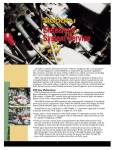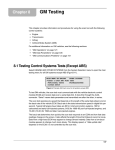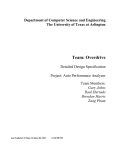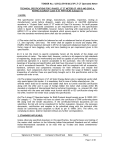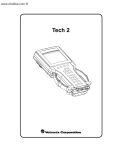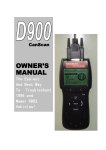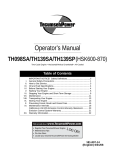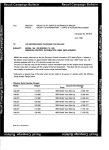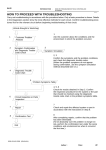Download 6.0L V8 Gas Engine Driveability Module 2
Transcript
6.0L V8 Gas Engine Driveability Module 2 Table of Contents Page Course Outline & Objectives 3 Section 1 Introduction to the OBD II Module Communications Controller Message Monitor Module Communications Enabling Criteria Diagnostic Trouble Code (DTC) DTC Type A DTC Type B DTC Type C Current/History DTCs Freeze Frame/Failure Records Saving Freeze Frame Data Multiple Codes Service Tips 4 6 7 8 9 10 11 12 13 14 15 16 17 18 Diagnostic Strategy Driveability Diagnosis Starting Point Diagnostic Strategy step 2 & 3 Diagnostic Strategy step 4 Diagnostic Strategy step 5 Diagnostic Strategy step 6 Diagnostic Strategy step 7 Diagnostic Strategy step 8 19 21 22 23 24 25 26 27 Heated Oxygen Sensors (HO2S) Oxygen Sensor Location Oxygen Sensor Construction Oxygen Sensor Signal Heated Oxygen Sensor Heater Circuit HO2S Heater Circuit Codes Oxygen Sensor Signal Circuit Pre-Catalyst H02S Signal Three-way Catalytic Converter Post-Catalyst HO2S Signals Catalyst Efficiency HO2S Diagnosis Service Tips 28 30 31 32 33 34 35 36 38 39 40 41 42 Section 2 Section 3 1 Table of Contents Page Section 4 Fuel System Diagnostics Closed Loop Mode Fuel Trim Values Fuel Trim Fuel Trim Codes Fuel Trim Cylinder Balance Diagnostic Tips Fuel Trim Reset 43 44 45 46 47 48 49 50 Misfire Diagnostics Engine Cycles Engine Misfire Causes of Misfire Ignition Misfire Misfire Caused by Fuel Delivery Misfire Monitoring Misfire Counters Recorded Misfire Events Misfire Diagnostic Tips CKP Variation Learn Procedure 51 52 53 54 56 57 58 60 61 62 63 Enhanced EVAP System Enhanced EVAP Operation FTP Sensor EVAP Test Criteria EVAP Codes EVAP System Large Leak Test Large Leak--Fuel Cap OFF EVAP System Small Leak Test EVAP Canister Vent Test EVAP Purge/Seal Test Service Tips 64 65 67 68 69 70 71 72 73 74 75 Section 5 Section6 Acronyms 76 2 6.0L V8 Gas Engine Driveability, Module 2 Section 1. 2. 3. 4. 5. 6. OBD II Diagnostics Diagnostic Strategy Heated Oxygen Sensors Diagnostics Fuel System Diagnostics Misfire Diagnostics Enhanced EVAP System Diagnostics Course Objectives: After completing this course, participants will be able to identify and be familiar with: • OBD II and Diagnostic Trouble Codes • Recommended Diagnostic Strategy • Scan tool data for Fuel, Ignition and Emissions • Fuel Trim data • Engine Misfire data • Enhanced EVAP System diagnostic testing 3 6.0L V8 Gas Engine Driveability Module 2 Section 1 On Board Diagnostics II 6.0L V8 Gas Engine Driveability Module 2, Section 1 On Board Diagnostics II • • • • Description of OBD II ECM system Monitoring Diagnostic Trouble Codes Freeze Frame/Failure Records 4 6.0L V8 Gas Engine Driveability Module 2 Section 1 On Board Diagnostics II OBD II Introduction to OBD II OBD II was first introduced in the mid-1990’s and is a sophisticated computer system that controls the engine and emissions operations. This system has extensive diagnostic capabilities that can monitor, detect and report vehicle emissions and performance malfunctions. When the vehicle's on-board computer detects a failure in an emissionsrelated component or system, the computer: • assigns a very specific diagnostic trouble code, or DTC • saves the code in the computer's memory, and • may light up the Malfunction Indicator Lamp (MIL) 5 6.0L V8 Gas Engine Driveability Module 2 Section 1 On Board Diagnostics II MODULE COMMUNICATIONS Module Communications As discussed in Module 1, the main components of the OBD II system are the Engine Control Module (ECM), the Transmission Control Module (TCM), the Powertrain Interface Module (PIM), and the Anti-Lock Brake System (ABS) module. The various modules communicate with each other and the diagnostic scan tool equipment, through a dual wire, high speed communication link called the CAN Bus. The Scan Tool connects to the Bus through the Data Link Connector (DLC). 6 6.0L V8 Gas Engine Driveability Module 2 Section 1 On Board Diagnostics II Controller Message Monitor Controller Message Monitor Communication between modules can be verified with IDSS using the Controller Message Monitor function. This screen shows all modules are active and transmitting data. 7 6.0L V8 Gas Engine Driveability Module 2 Section 1 On Board Diagnostics II MODULE COMMUNICATIONS Checking Module Communications If there is a failure to communicate between any of the on board modules, check the resistance between the high and low circuits of the CAN lines. A normal reading should be around 60 ohms. If it is 120 ohms or higher, there could be a bad resistor in the module or an open in the CAN line. 8 6.0L V8 Gas Engine Driveability Module 2 Section 1 On Board Diagnostics II Enabling Criteria and Drive Cycle Enabling Criteria and Drive Cycle Enabling Criteria is a specific set of conditions that must be met before the ECM can run any of the diagnostic tests. Some tests will only run during an extended set of driving procedures known as the Drive Cycle, or Ignition Cycle. This is also sometimes referred to as a Trip. An example of a Drive Cycle would start when the ignition key is turned “ON” and includes the vehicle reaching a certain temperature, speed, and Loop status, then end when the vehicle is shut off. If all enabling conditions are met, and the diagnostic test fails, a Diagnostic Trouble Code (DTC) could set. 9 6.0L V8 Gas Engine Driveability Module 2 Section 1 On Board Diagnostics II Diagnostic Trouble Code (DTCs) Diagnostic Trouble Codes (DTCs) DTCs can be retrieved using the IDSS and are displayed as five-digit alphanumeric codes. • The first digit is a letter which designates what computer control module it came from. For example, the ECM or Powertrain module. • The second digit is a number which indicates whether it is generic or manufacturer specific. • The third digit is a number which points at the specific system. For example the number 1 represents Fuel and Air Metering. The number 2 represents an injector circuit. The ignition system is represented by the number 3, and an auxiliary emission control system by the number 4. • The fourth and fifth digits identify the section of the system that is malfunctioning which will be defined when referencing the service information. 10 6.0L V8 Gas Engine Driveability Module 2 Section 1 On Board Diagnostics II DTC Type A Examples: • P0120 - Throttle Position (TP) Sensor 1 Circuit • P0122 - Throttle Position Sensor 1 Circuit Low Voltage • P0123 - Throttle Position Sensor 1 Circuit High Voltage DTC Type A Type A Diagnostic Trouble Codes (DTCs) are the most serious and will turn on the Malfunction Indicator Lamp (MIL) as soon as the ECM detects a problem. Some examples of Type A codes are: • P0120, which means that the ECM has identified a malfunction on Throttle Position Sensor 1 Circuit. • P0122 indicating the ECM is seeing low voltage on the Throttle Position Sensor 1 Circuit. • P0123 indicating that the ECM is seeing high voltage on the Throttle Position Sensor 1 Circuit. When a Type A code is set, the OBD II system stores it as a History code. It also stores Freeze Frame and Failure Record Data. This stored data can be very helpful in diagnosing the problem and will be discussed later in this section. 11 6.0L V8 Gas Engine Driveability Module 2 Section 1 On Board Diagnostics II DTC Type B Examples: • P0101 - Mass Air Flow (MAF) Sensor Performance • P0116 - Engine Coolant Temperature (ECT) Sensor Performance DTC Type B Type B Codes indicate a fault but of a less serious concern to vehicle emissions. An example of a Type B Code would be: • P0101 Mass Air Flow Sensor Performance • P0116 Engine coolant Temperature Sensor Performance In the case of a Type B Code, the fault must occur on two consecutive Drive Cycles before the MIL lamp will come on. If a fault occurs during one Drive Cycle but not during the next, the code won't "mature" and the MIL lamp will remain off. Only when all the conditions are met on two back to back Drive Cycles will a History Code set and the MIL lamp come on. 12 6.0L V8 Gas Engine Driveability Module 2 Section 1 On Board Diagnostics II DTC Type C Example of Type C Codes-Non Emission related • U0140 - Lost Communication with Powertrain Interface Module (PIM) • P0564 - Cruise Control Multi-Function Switch Circuit DTC Type C Type C Codes are non-emission related. These codes do not turn on the MIL lamp, but may turn on a separate indicator lamp such as the SERVICE VEHICLE SOON LIGHT. An example of a Type C Code would be: • U0140 Lost Communication with Powertrain Interface Module • P0564 Cruise Control Multi-function Switch Circuit 13 6.0L V8 Gas Engine Driveability Module 2 Section 1 On Board Diagnostics II Current/History DTCs Current/History DTCs: • Current codes are based on real time data and reflect conditions that are currently present. Type A codes stay current until cleared. • History codes are stored in ECM memory and indicate a failure occurred but may not be currently present. This IDSS screen shows both. • An Intermittent condition can cause a History code to be stored in memory. If it is a Type B code, and the failure hasn’t occurred two consecutive times, it isn’t mature yet so the MIL lamp may not come on. 14 6.0L V8 Gas Engine Driveability Module 2 Section 1 On Board Diagnostics II Freeze Frame/Failure Records Freeze Frame/Failure Records As stated earlier, when a Type A or B code sets, the ECM saves a record of data. The data saved is of actual engine conditions at the time that the failure occurred and is viewed on the scan tool as Freeze Frame/Failure Records. This record will include many critical parameters such as Engine Coolant Temperature, Fuel Trim, Engine Speed, and Vehicle Speed. It’s important to note that if more than one DTC is stored, only the code stored first will store a Freeze Frame Record. Additional codes will store only Failure Records. This information can be very helpful when trying to diagnose an intermittent condition. 15 6.0L V8 Gas Engine Driveability Module 2 Section 1 On Board Diagnostics II Saving Freeze Frame Data Saving Freeze Frame/Failure Records It’s a good idea to always save Freeze Frame and Failure Records Data before clearing codes. If not saved, data records will be lost. To do this, go to the Scan Tool menu in IDSS and click on DTCs. 1) Double click on the stored DTC. 2) Click on Freeze Frame/Failure Records. 3) Click Save. 4) Click OK. After data has been saved, click on Utility Functions to open Saved Freeze Frame/Failure Records. 16 6.0L V8 Gas Engine Driveability Module 2 Section 1 On Board Diagnostics II Multiple Codes Multiple Codes It’s not uncommon for more than one DTC to be stored. When there are multiple codes, it can be difficult to know where to begin diagnosis. The correct diagnostic strategy is to always start with the first code stored, which is the DTC that has saved Freeze Frame data. 17 6.0L V8 Gas Engine Driveability Module 2 Section 1 On Board Diagnostics II Service Tips Service Tips When analyzing scan tool data, if a sensor signal is out of range, do not assume it is a bad sensor. For instance, a Mass Air Flow Sensor with a loose or corroded connection will be out of range and can cause poor performance, stalling, and hard starting. This can even cause an intermittent DTC to set. The sensor may be OK, just the connector needs to be repaired. 18 6.0L V8 Gas Engine Driveability Module 2 Section 2 Diagnostic Strategy 6.0L V8 Gas Engine Driveability Module 2, Section 2 Diagnostic Strategy • Introduction to Diagnostic Strategy • Diagnostic Starting Point • Code or No Code Diagnostics 19 6.0L V8 Gas Engine Driveability Module 2 Section 2 Diagnostic Strategy Diagnostic Strategy Diagnostic Strategy, Step #1 Strategy Based Diagnosis provides a systematic approach to diagnosing the vehicle, in other words, a plan of action. Using this strategy helps reduce diagnostic time and improves the chances to fix it right the first time. Each customer’s concern may be different but the basic Diagnostic Strategy is always the same. Step #1 is to verify the customer’s concern. It’s important to understand this before doing anything else. 20 6.0L V8 Gas Engine Driveability Module 2 Section 2 Diagnostic Strategy Driveability Diagnosis Starting Point Isuzu Repair Service REPAIR ORDER WORK PERFORMED CUSTOMER INFORMATION Name Date Staff Ph# Address City State PAYMENT Zip Make Year Odometer OTHER License# Vin# CUSTOMER CONCERNS Hard starting, low power, stalls and hesitates. Down Payment Yes No Amount $ I hereby authorize NAME OF COMPANY to perform the above work to be done with the necessary materials and grant permission to operate car/truck herein described on streets or highways for the purpose of testing. As explained to me a mechanics lien may be placed on said vehicle in order to obtain unpaid repairs/services left at Joe’s Diesel Service for more than 30 days. I understand JDS is not responsible for loss or damage to vehicles or articles left in car/trucks in case of fire, theft or any other cause beyond our control. ________________________________________________________________ Customer Signature Date Cash Check Charge RATE Labor Serv Call Hourly PM Call CHARGES Labor Hours $ Parts $ Gas/Oil/Grease $ Outside Repairs $ Storage Fee(s) $ Tax $ AMOUNT DUE $ The Work Order Most driveability diagnosis starts with the work order. The first step is “understanding” what the customer is experiencing and verifying the symptoms. It may be necessary to talk to the customer or operate the vehicle if information on the work order is vague or incomplete. 21 6.0L V8 Gas Engine Driveability Module 2 Section 2 Diagnostic Strategy Diagnostic Strategy Diagnostic Strategy, Step #2 and #3 Step #2 is to determine if the customer’s concern is a normal operating characteristic. It is very important not to attempt repairs in an attempt to appease the customer if the vehicle is operating as designed. It can be helpful to use a known good vehicle for comparison. If the customers concern is verified, go on to the next step. Step #3 is to perform preliminary checks including a very careful visual inspection. Don’t skip this step because it can often lead to identifying the concern quickly and save time. Even if the MIL lamp is on, indicating there is a current DTC, don’t skip the visual inspection. A DTC may point you in the right direction, but sometimes, it can be misleading. It’s also important to keep in mind that the OBD II system assumes that the mechanical systems are all functioning properly. With all the electronics on the vehicle, it’s easy to overlook the basic mechanical systems. 22 6.0L V8 Gas Engine Driveability Module 2 Section 2 Diagnostic Strategy Diagnostic Strategy Diagnostic Strategy, Step #4: Step #4 is to perform the Diagnostic System Check. This is found in the service manual and performing this check will: • Identify what control modules are commanding the system • Verify the ability of the control modules to communicate • And identify if any DTCs are stored and if they are current or history Record all DTC’s on the repair order for future reference before clearing codes. 23 6.0L V8 Gas Engine Driveability Module 2 Section 2 Diagnostic Strategy Diagnostic Strategy Diagnostic Strategy, Step #5 Step #5. is to check for bulletins. This can save a lot of time and effort. 24 6.0L V8 Gas Engine Driveability Module 2 Section 2 Diagnostic Strategy Diagnostic Strategy Diagnostic Strategy, Step #6 In Step #6, the diagnostic path will be determined by what was learned from the Diagnostic System Check: • If there is a current code, follow the correct procedure in the service manual. If there are multiple codes, start with the first code set. • If symptoms seem to be intermittent, check for a history code. If there is one, refer to the DTC chart in the service manual. This may help get to the root cause. • If there are no codes stored, diagnostics will be based on the emissions or drivability conditions. • If there is no code and no published diagnostics related to the concern, it may be necessary to call the Technical Assistance Center. 25 6.0L V8 Gas Engine Driveability Module 2 Section 2 Diagnostic Strategy Diagnostic Strategy Diagnostic Strategy, Step #7 Following the Diagnostic Strategy and the procedures as outlined in the service information, should eventually lead to finding the root cause of the concern. If not, it may be necessary to re-examine the information from the beginning. 26 6.0L V8 Gas Engine Driveability Module 2 Section 2 Diagnostic Strategy Diagnostic Strategy Isuzu Repair Service REPAIR ORDER WORK PERFORMED CUSTOMER INFORMATION Name Visually inspected vehicle. Test drive vehicle. Scan vehicle for DTCs. Found P0300 Checked for service bulletins And recalls. Check fuel system pressure. Fuel pressure low. Inspect fuel lines and check Electrical circuit at pump. Address City State PAYMENT Zip Make Year Odometer OTHER Date Staff Ph# License# Vin# CUSTOMER CONCERNS Hard starting, low power, stalls and hesitates. Replace fuel pump and clear codes. Test drive okay. Down Payment Yes No Amount $ I hereby authorize NAME OF COMPANY to perform the above work to be done with the necessary materials and grant permission to operate car/truck herein described on streets or highways for the purpose of testing. As explained to me a mechanics lien may be placed on said vehicle in order to obtain unpaid repairs/services left at Joe’s Diesel Service for more than 30 days. I understand JDS is not responsible for loss or damage to vehicles or articles left in car/trucks in case of fire, theft or any other cause beyond our control. ________________________________________________________________ Customer Signature Date Cash Check Charge RATE Labor Serv Call Hourly PM Call CHARGES Labor Hours $ Parts $ Gas/Oil/Grease $ Outside Repairs $ Storage Fee(s) $ Tax $ AMOUNT DUE $ Diagnostic Strategy, Step #8 The final step after the root cause has been identified and the vehicle repaired, is to clear codes and verify the fix. Remember that some codes require two ignition cycles to turn on the MIL lamp so always recheck for codes when verifying the fix. 27 6.0L V8 Gas Engine Driveability Module 2 Section 3 Heated Oxygen Sensors 6.0L V8 Gas Engine Driveability Module 2, Section 3 Heated Oxygen Sensors (HO2S) • • • • Pre-catalyst Heated Oxygen Sensors Post-catalyst Heated Oxygen Sensors Catalyst Monitoring Diagnostics and Service 28 6.0L V8 Gas Engine Driveability Module 2 Section 3 Heated Oxygen Sensors Heated Oxygen Sensor (HO2S) Heated Oxygen Sensors (HO2S) The 6.0L gas engine has four Heated Oxygen Sensors, also referred to as HO2S, that provide important information to the ECM for fuel control and catalytic converter monitoring. 29 6.0L V8 Gas Engine Driveability Module 2 Section 3 Heated Oxygen Sensors Oxygen Sensor Location Oxygen Sensor Location The two Pre-Catalyst Oxygen Sensors are located in the exhaust pipes before the catalytic converters. The signals from the Pre-Catalyst Oxygen Sensors provide critical information to the ECM when the system is in Closed Loop. By monitoring the Oxygen Sensor signals, the ECM constantly adjusts fuel delivery, trying to maintain an air-to-fuel ratio of 14.7:1, the optimal air/fuel ratio for low emissions and driveability. The ECM uses the two Post-Catalyst Oxygen Sensor signals to monitor the efficiency of the Catalytic Converters. The Pre-Catalyst Oxygen Sensor on the driver side is referred to as Bank 1, Sensor 1. Bank 1, Sensor 2 is a Post-Catalyst Oxygen Sensor and is located on the passenger side after the Catalytic Converter. This is because the exhaust pipes cross over. The Pre-Catalyst Oxygen Sensor on the passenger side is referred to as Bank 2, Sensor 1. Bank 2 Sensor 2 is a Post-Catalyst Oxygen Sensor and is located after the Catalytic Converter on the driver side. 30 6.0L V8 Gas Engine Driveability Module 2 Section 3 Heated Oxygen Sensors Oxygen Sensor Construction Oxygen Sensor Construction An Oxygen Sensor is simply a thimble shaped battery that produces a very low voltage, less than one volt. The inner surface of the sensor is exposed to outside air which contains 21% oxygen. This air enters the center of the sensor through the wire connector. The outside surface of the Oxygen Sensor element is exposed to exhaust gases, containing far less oxygen or no oxygen at all after combustion. This difference in oxygen levels in the exhaust verses outside air creates a chemical reaction that produces the very low voltage signal. 31 6.0L V8 Gas Engine Driveability Module 2 Section 3 Heated Oxygen Sensors Oxygen Sensor Signal Oxygen Sensor Signal Oxygen Sensor output voltage will normally be between 100 and 900 mV. When there is a rich air fuel mixture nearly all the oxygen will be burned up during combustion, leaving little to no oxygen in the exhaust. This produces a higher voltage output from the sensor. If the air fuel mixture is lean there is likely to be unburned oxygen in the exhaust. The sensor reacts to this by producing a lower voltage. 32 6.0L V8 Gas Engine Driveability Module 2 Section 3 Heated Oxygen Sensors Heated Oxygen Sensor Circuit HO2S Heater Circuit The Heated Oxygen Sensor (HO2S) is a four wire sensor: two wires carry the signal to the ECM and two wires are for the heater circuit. In order for the HO2S to provide an active signal, it must be at operating temperature. The sensors are located some distance from the engine exhaust ports and would be slow to heat up if relying on just engine temperature. Instead, the sensors have an internal electric heater that brings them up to operating temperature in just seconds. The heater circuit voltage comes from the ignition circuit. Once the ignition is turned ON, the ECM grounds the heater low control circuit and the HO2S reaches operating temperatures in less than 90 seconds. The ECM uses pulse width modulation on the ground side to maintain a steady operating temperature. To make sure the heaters are working, the ECM monitors the amperage and the voltage on the HO2S heater low control circuit. If the ECM detects something out of range, a DTC will set. 33 6.0L V8 Gas Engine Driveability Module 2 Section 3 Heated Oxygen Sensors H02S Heater Circuit Codes HO2S Heater Circuit Codes There are 42 codes associated with the HO2S and 12 of these codes are associated with the heater circuit. If an Oxygen Sensor heater circuit code sets, don’t assume the heater element has failed. It’s a good idea to inspect the wiring and connectors leading to the sensor for possible damage. 34 6.0L V8 Gas Engine Driveability Module 2 Section 3 Heated Oxygen Sensors Oxygen Sensor Signal Circuit HO2S Signal Circuit The ECM applies a reference voltage, also referred to as a bias voltage, of 450 mV to the HO2S signal wire. The ECM determines if the system is rich or lean, depending on whether the voltage generated by the sensor is greater than or less than 450 mV. 35 6.0L V8 Gas Engine Driveability Module 2 Section 3 Heated Oxygen Sensors Pre-Catalyst H02S Signal Pre-Catalyst HO2S Signal Each time the exhaust valve opens the oxygen levels in the exhaust change. This is why the oxygen sensor signal rapidly cycles between 100 and 900 mV while the engine is running. Voltage above 450 mV indicates a rich exhaust and voltage below 450 mV indicates a lean exhaust. The ECM is continuously adjusting the fuel to maintain the optimum air/fuel ratio. This is referred to as Fuel Trim, and will be discussed later in this section. 36 6.0L V8 Gas Engine Driveability Module 2 Section 3 Heated Oxygen Sensors Pre-Catalyst H02S Signals Pre-Catalyst HO2S Bank 1/Bank2 Signals The ECM monitors the HO2S signal voltage for: • response rate • signal range • various other parameters If the sensor signal rate is too slow, too fast, or the signal is beyond the normal limit, the ECM will interpret this as a defective sensor, set a DTC and illuminate the MIL. When a HO2S signal DTC sets it may not mean the Oxygen Sensor is defective. Conditions such as fuel delivery or misfire can also cause these DTCs to set so be sure to follow the diagnostic charts carefully. 37 6.0L V8 Gas Engine Driveability Module 2 Section 3 Heated Oxygen Sensors Three-way Catalytic Converter Three-way Catalytic Converter The best air/fuel ratio for combustion and emissions control is 14.7 to 1. This air/fuel ratio is also what allows the Catalytic Converter to work efficiently. The three-way Catalytic Converter reduces exhaust gas emissions, mainly oxides of nitrogen (NOx), hydrocarbons (HC), and carbon monoxide (CO). In the first stage of the converter, the catalyst promotes a chemical reaction which reduces the NOx, into nitrogen and oxygen. When the Catalytic Converter is working efficiently, it stores oxygen to be used for converting HC and CO emissions into water vapor and carbon dioxide. If the catalyst is functioning correctly and the oxygen storage capacity is working, tail pipe emissions are minimal. 38 6.0L V8 Gas Engine Driveability Module 2 Section 3 Heated Oxygen Sensors Post-Catalyst H02S Signals Post-Catalyst HO2S Signal The ECM monitors the catalytic converter efficiency using the Post-Catalyst HO2S. If the catalyst is working, there will be very little fluctuation in the oxygen levels coming out of the converter. This is evident by the Post-Catalyst HO2S signals being far less active than the signals produced by the Pre-Catalyst Oxygen Sensors. The signal shown here indicates that the catalytic converter oxygen storage capacity is at an acceptable level. When the response time of the Post-Catalyst HO2S are close to that of the Pre-Catalyst Sensor, this may indicate that the converter is not working properly and may have come apart internally. 39 6.0L V8 Gas Engine Driveability Module 2 Section 3 Heated Oxygen Sensors Catalyst Efficiency Catalyst Efficiency The ECM monitors the Post-Catalyst Oxygen Sensor signals and if there is an indication of low efficiency, a DTC will set. There may also be symptoms such as a rough/hard idle when cold, or rattling noise from the converter. There may be no noticeable driveability concerns and the only indication is the DTC set. 40 6.0L V8 Gas Engine Driveability Module 2 Section 3 Heated Oxygen Sensors HO2S Diagnosis Visual/Physical Inspection • Inspect sensor, electrical connections, and harness • Inspect the exhaust system • Check fuel pressure, look for vacuum leaks HO2S Diagnosis If engine performance or scan tool data suggest a potential HO2S malfunction, don't forget the basics. • Always conduct a visual inspection of the electrical connections and wiring harness. Electrical connections should be clean and tight. Be sure the wiring harness is routed away from hot exhaust pipes. • Inspect the exhaust for leaks or holes that may affect the oxygen sensor readings. The HO2S measures oxygen, so a tightly sealed exhaust system is very important for accurate sensor readings. • Remember that improper fuel pressure or vacuum leaks can also cause HO2S readings to be out of range. 41 6.0L V8 Gas Engine Driveability Module 2 Section 3 Heated Oxygen Sensors Service tips Service Tips If the heated oxygen sensor pigtail wiring, connector, or terminals are damaged, replace the entire heated oxygen sensor assembly. Do not attempt to repair it. In order for the sensor to function properly, a clean air reference must pass through the sensor wires. Any attempt to repair the wires, connectors, or terminals could result in the obstruction of the air reference and degrade sensor performance. When installing an oxygen sensor, apply anti-seize to the threads only. Avoid getting the anti-seize anywhere else on the sensor, and refer to service information for proper torque. 42 6.0L V8 Gas Engine Driveability Module 2 Section 4 Fuel System Diagnostics 6.0L V8 Gas Engine Driveability Module 2, Section 4 Fuel System Diagnostics • Closed Loop Fuel Control • Short and Long Term Fuel Trim • Diagnostic Tips 43 6.0L V8 Gas Engine Driveability Module 2 Section 4 Fuel System Diagnostics Closed Loop Mode Closed Loop Mode As discussed in module 1, the system enters Closed Loop Fuel Control Mode shortly after start up, once the Heated Oxygen Sensors (HO2S) are providing feedback. As long as the engine is running, the ECM manages fuel delivery based on the signals from the HO2S and many other critical inputs. In Closed Loop, the ECM is constantly fine tuning, or correcting, the fuel delivery to maintain as close to 14.7:1 air/fuel ratio as possible. This constant correction is called Fuel Trim. 44 6.0L V8 Gas Engine Driveability Module 2 Section 4 Fuel System Diagnostics Fuel Trim Values Fuel Trim Values Fuel Trim is shown as a positive or negative value that represent the adding or subtracting of fuel from the engine. A Positive Fuel Trim Value indicates the ECM is adding fuel in order to compensate for a lean condition. A Negative Fuel Trim value indicates that the ECM is reducing the amount of fuel to compensate for a rich condition. 45 6.0L V8 Gas Engine Driveability Module 2 Section 4 Fuel System Diagnostics Fuel Trim Short Term/Long Term Fuel Trim Fuel Trim can be viewed using a scan tool and is useful when diagnosing driveability concerns. Short Term Fuel Trim represents the constant fine tuning of the fuel delivery system. Short Term Fuel Trim values show what the “current” fuel correction is in response to the input signal from the Pre-Catalyst Oxygen Sensors. Long Term Fuel Trim values, on the other hand, are the fuel delivery corrections that has been “learned” over time. This is a coarser fuel correction that the ECM stores in long term memory to adjust for rich or lean conditions or to compensate for normal wear and aging. 46 6.0L V8 Gas Engine Driveability Module 2 Section 4 Fuel System Diagnostics Fuel Trim Codes Fuel Trim Codes The ECM constantly monitors the Fuel Trim values. If they exceed the allowable percentage over a certain time period, a DTC will set. Note that Fuel Trim Codes are Type B codes so it will take two consecutive ignition cycles, with all the Enabling Criteria to be met, for the MIL to come on. 47 6.0L V8 Gas Engine Driveability Module 2 Section 4 Fuel System Diagnostics Fuel Trim Cylinder Balance Fuel Trim Cylinder Balance On the scan tool, the Fuel Trim Average is shown as a percentage and helps identify a rich or lean condition that is occurring in one bank of the engine. For example, if only one cylinder is rich, perhaps from a leaking injector, the HO2S Sensor on that bank may not be completely out of range, but the ECM will consistently see signals that are above the desired value. The number shown as the Fuel Trim Average is one way to narrow down which bank has a cylinder that is richer than the others. A positive number indicates there is a lean condition and a negative number indicates a rich condition. 48 6.0L V8 Gas Engine Driveability Module 2 Section 4 Fuel System Diagnostics Diagnostic Tips Beware of non-OE Parts such as: • Oxygen Sensor • Air Filters • Exhaust components All can cause DTCs Diagnostic Tips Non-OE sensors, an incorrect part number, or certain aftermarket parts, such as oxygen sensors and air filters, can cause DTCs to set. Induction system modifications, or non-OE exhaust system components can affect the HO2S signals and fuel delivery. Be sure to look for these conditions when doing the preliminary visual inspection. 49 6.0L V8 Gas Engine Driveability Module 2 Section 4 Fuel System Diagnostics Fuel Trim Reset Click on Fuel Trim Reset Fuel Trim Reset After doing any type of performance repair, it is a good idea to reset Fuel Trim. This will reset the Long Term Fuel Trim values back to zero percent and the fuel delivery back to factory preset values. Skipping this step could cause poor performance until the ECM has had time to relearn Fuel Trim on it’s own. To do this, go to the Scan Tool menu in IDSS and click on Output Control Tests. 1) Then click on Engine. 2) Advance the arrow on the right to get to Fuel Trim Reset and click on it. 3) Click the Reset box. 4) Then Stop Test. Return to Data Display and click on Fuel Trim Data to view changes. 50 6.0L V8 Gas Engine Driveability Module 2 Section 5 Misfire Diagnostics 6.0L V8 Gas Engine Driveability Module 2, Section 5 Misfire Diagnostics • • • • Causes of Engine Misfire Misfire Monitoring Misfire Counters Diagnostic Tips 51 6.0L V8 Gas Engine Driveability Module 2 Section 5 Misfire Diagnostics Engine Cycles Four Stroke Engine Cycles During normal combustion of a four stroke gasoline engine, ignition is a precisely timed occurrence during the compression cycle. When the air/fuel mixture in the cylinder does not ignite properly, it is called Misfire. The cause of misfire can be mechanical, electrical, or related to the fuel system. It can also be a combination of these. 52 6.0L V8 Gas Engine Driveability Module 2 Section 5 Misfire Diagnostics Engine Misfire Misfire Symptoms: • Rough running engine • Engine shake • Hard start or stall • Low power • Poor performance, fuel economy, and emissions Engine Misfire Although misfire is a common driveability complaint, it is not easily diagnosed. Symptoms of misfire vary. It may cause a rough running engine or the engine may shake so badly that it causes vibrations throughout the vehicle. The engine can be hard to start, or stall at idle, depending on the load. Or, it may simply cause the engine to feel sluggish or low on power. Whatever the symptoms, when misfire occurs, performance suffers along with fuel economy and emissions. 53 6.0L V8 Gas Engine Driveability Module 2 Section 5 Misfire Diagnostics Causes of Misfire Causes of Misfire When the compression in a cylinder is too low, the air/fuel mixture will not burn properly and can result in misfire. Worn components such as: • Piston rings • Cylinder walls • Valves or springs • Cam to roller lifter contact, and • Leaking head gaskets can all cause low cylinder compression Procedures that can help diagnose this condition include, Cranking Compression Test, Cylinder Leak Down Testing, and a Running Compression Test. Refer to the service information in the engine mechanical section for information on how to perform these procedures or contact Isuzu Technical Assistance for help. 54 6.0L V8 Gas Engine Driveability Module 2 Section 5 Misfire Diagnostics Causes of Misfire Causes of Misfire (continued) Here are some other conditions to look for: • When performing a visual inspection, check vacuum hoses, intake gaskets, the PCV system, and valve cover seals for vacuum leaks. • Check for a restricted air cleaner. This can limit the amount of intake air, causing the air fuel mixture to be too rich. • Inspect for damaged or restricted exhaust, which can cause higher than normal backpressure. This can cause misfire in all cylinders on one bank of the engine. If this is the case, you may need to use a back pressure gauge like the one shown above. Refer to the service information for exhaust system diagnosis. 55 6.0L V8 Gas Engine Driveability Module 2 Section 5 Misfire Diagnostics Ignition Misfire • Worn or fouled spark plugs • Worn or faulty spark plug wires • A weak or failed ignition coil • Low alternator output • Poor battery cable connections Ignition Misfire A no-spark condition is a common cause of misfire. This can be due to: • worn or fouled spark plugs • worn or faulty spark plug wires • weak or failed ignition coil or wire harness connections For the ignition system to function, it must have adequate voltage. If the alternator output is low, it can cause a no-spark condition. The same is true if there is a poor battery cable connection or if engine grounds are loose or corroded. These conditions also affect the available voltage for the ignition system to function properly. 56 6.0L V8 Gas Engine Driveability Module 2 Section 5 Misfire Diagnostics Misfire Caused by Fuel Delivery • Restricted Injectors • Leaking Injectors • Electrical problems • Low fuel pressure • Poor fuel quality or contamination Misfire Caused by Fuel Delivery For normal combustion to take place, there must be the right amount of fuel and air in the cylinder. If the mixture is too lean, or too rich, it may not ignite and burn, even if there is a spark. One way to check if a misfire condition is because of a rich or lean condition is to check the HO2S data. The Long Term Fuel Trim can be very helpful for this. Some fuel system conditions that may cause misfire include: • Restricted Injectors causing a lean condition • Leaking Injectors causing a rich condition • Electrical conditions causing an Injector not to fire properly • Low fuel pressure due to pinched fuel lines, restrictions, or low Fuel Pump output • Misfire can also be caused by poor fuel quality or contamination 57 6.0L V8 Gas Engine Driveability Module 2 Section 5 Misfire Diagnostics Misfire Monitoring Reluctor Wheel Misfire Monitoring As stated earlier, misfire results in poor fuel economy and excessive tailpipe emissions. For this reason, the OBD II system has continuous misfire monitoring. The ECM can detect a misfire by watching certain inputs, mainly the Crankshaft and Camshaft Position Sensors. When a misfire occurs, that cylinder does not produce the same amount of power as one with normal combustion. As a result, the crankshaft slows down each time a cylinder misfires. The Crankshaft Position Sensor can sense these engine speed fluctuations by the changes in the reluctor wheel speed. 58 6.0L V8 Gas Engine Driveability Module 2 Section 5 Misfire Diagnostics Misfire Monitoring Misfire Monitoring on IDSS The ECM uses the Camshaft Position Sensor to determine exactly which cylinder, or cylinders, the misfire is coming from. Here, the IDSS screen shows cylinder #4 with a misfire. This shows both current and history data, which can be helpful to determine how long the condition has been present. 59 6.0L V8 Gas Engine Driveability Module 2 Section 5 Misfire Diagnostics Misfire Counts Misfire Counters Current and History misfire counts are stored in ECM memory. The Misfire Current Counts display real time data. Every 200 cylinder firing events, the misfire counts are saved in the Misfire History Counts file. The History Counts accumulate over time and can be an important diagnostic tool. For instance, an intermittent misfire may be enough to cause a performance concern, but not set a DTC. Be aware that Misfire History Counts will reset to zero when you clear codes. Be sure to check misfire data “before” clearing codes to avoid loosing this important diagnostic information. 60 6.0L V8 Gas Engine Driveability Module 2 Section 5 Misfire Diagnostics Misfire Events Recorded Types of Catalyst Events: • Non-Catalyst Damaging • Catalyst Damaging Recorded Misfire Events When misfire is detected, a DTC P0300 will set. The ECM will respond differently, depending on how severe the misfire is. When a Non-Catalyst Damaging Misfire occurs and a DTC sets, the MIL lamp comes on solid and stays on. This is a misfire that happened only a few times within 1,000 to 3,200 engine revolutions. An example of this would be a misfire caused by a partially restricted injector. When a Catalyst Damaging Misfire occurs, the MIL lamp will flash on and off as long as the condition persists. This misfire is happening more frequently, within 200 engine revolutions, and is considered severe. An example of this would be the misfire created by a failed spark plug wire. The Catalytic Converter can be damaged from all the unburned fuel in the exhaust and the flashing MIL lamp is a warning to the driver. 61 6.0L V8 Gas Engine Driveability Module 2 Section 5 Misfire Diagnostics Misfire Diagnostic Tips Diagnostic Tips Because DTCs can be set by mechanical, as well as electrical or OBD II systems concerns, always follow the recommended Diagnostic Strategy and begin with the Diagnostic Starting Point. If the MIL lamp is on and there are multiple codes set along with a DTC P0300, it is recommended that you diagnose all other DTC’s first, before diagnosing the misfire DTC. This is because the other codes could be indicating a fault that is causing the misfire. One way to pin point a component suspected of causing misfire is to swap parts, such as ignition coils, plug wires, and injectors, between cylinders, one at a time. If the part is at fault, the misfire counts will follow the failed part. Important: Perform a Crankshaft Variation Learn procedure after repairs. This should be done only if no other codes are set. 62 6.0L V8 Gas Engine Driveability Module 2 Section 5 Misfire Diagnostics CKP System Variation Learn As mentioned in Module 1, it is a good idea to perform a Crankshaft Variation Learn Procedure after certain repairs. This is done by selecting ECM Output Control Test, CKP Variation Learn tab in IDSS. This resets and calibrates the Crankshaft Position Sensor (CKP) to reluctor wheel relationship. Follow the Test Criteria provided in the box on the screen. 63 6.0L V8 Gas Engine Driveability Module 2 Section 6 Enhanced EVAP System 6.0L V8 Gas Engine Driveability Module 2, Section 6 Enhanced EVAP System • • • • System operation Diagnostic Trouble Codes System Monitoring and Diagnostic Tests Diagnostic Service Tips 64 6.0L V8 Gas Engine Driveability Module 2 Section 6 Enhanced EVAP System Enhanced EVAP Operation Enhanced EVAP System Operation The purpose of the Enhanced Evaporative Emissions, or EVAP, System is to prevent fuel vapor from escaping into the atmosphere. Fuel vapors from the tank are stored in a Charcoal Canister, until they can be routed through the Vapor Lines to the intake manifold and burned during normal combustion. The Vent Solenoid is located on the EVAP Canister and is normally open to allow fresh air into the canister. The Purge Solenoid, located in the vapor line between the canister and the engine, is normally closed so vapors cannot be drawn into the engine until the right running conditions are met. 65 6.0L V8 Gas Engine Driveability Module 2 Section 6 Enhanced EVAP System Enhanced EVAP Operation Enhanced EVAP System Operation Under certain running conditions the ECM will purge the fuel vapors from the canister by commanding the Purge Solenoid to turn ON. This opens the valve and allows engine vacuum to draw on the EVAP Canister. The EVAP Vent solenoid remains OFF and in the open position, allowing fresh air to be drawn through the canister. The air mixes with the stored fuel vapors and is pulled into the intake manifold to be burned during normal combustion. 66 6.0L V8 Gas Engine Driveability Module 2 Section 6 Enhanced EVAP System FTP Sensor Fuel Tank Pressure (FTP) Sensor Fuel Tank Pressure (FTP) Sensor The reason this is called an “Enhanced” EVAP system is because of the on-board diagnostic capabilities. The ECM can perform functional tests to monitor the purge system to detect system leaks. It is the Fuel Tank Pressure (FTP) Sensor, located on the top of the fuel tank sending unit, which gives the ECM the necessary feedback to determine if the system is working properly. 67 6.0L V8 Gas Engine Driveability Module 2 Section 6 Enhanced EVAP System EVAP Test Criteria • No DTC’s • Fuel level between 15 – 85% • Temperatures between 40°F – 100°F • Vehicle speed steady, or engine off EVAP Test Criteria For the ECM to perform these EVAP tests, certain Enabling Criteria must be met. For example: • No current DTC’s can be present and the malfunction indicator lamp must be off • Fuel level must be stable and between 15 and 85 percent • Ambient temperature needs to be between 40°F and 100°F • Vehicle speed and load conditions steady, or engine shut off Because these Enabling Criteria are very specific, it is possible that the ECM will not run these tests every time the vehicle is driven. 68 6.0L V8 Gas Engine Driveability Module 2 Section 6 Enhanced EVAP System EVAP Codes EVAP Codes This is a list of some of the Diagnostic Trouble Codes specific to the EVAP System. Refer to the service information for more on these DTC’s and additional Enhanced EVAP System diagnostics. 69 6.0L V8 Gas Engine Driveability Module 2 Section 6 Enhanced EVAP System EVAP System Large Leak Test EVAP System Large Leak Test One of the functional tests that the ECM performs is the Large Leak Test. While the engine is running, the ECM turns “ON” both the Vent and the Purge Solenoid Valves. This will close the Vent Valve and open the Purge Valve, allowing engine vacuum to draw on the fuel tank. The ECM then monitors the FTP Sensor to see if the system is able to reach a specific level of vacuum within a set amount of time. Next, the ECM commands the EVAP Purge Solenoid Valve “OFF”. This seals the system, and the ECM monitors the FTP Sensor to see if the vacuum holds. If the specific vacuum level is not reached, or the vacuum does not hold once the system is sealed, the system fails the Large Leak Test. Since this is a Type B failure code, the system must fail this test on two consecutive trips before a DTC will set. 70 6.0L V8 Gas Engine Driveability Module 2 Section 6 Enhanced EVAP System Large Leak (Fuel Cap Off) Large Leak Test- Fuel Cap Off The most common condition for the Large Leak Test to fail is when the fuel fill cap is not tightened properly after a refueling. The ECM can detect when the vehicle has been refueled based on information from the Fuel Sender unit and may run a Large Leak Test right away. This is a Type B code so it may take several trips for the MIL lamp to come on. 71 6.0L V8 Gas Engine Driveability Module 2 Section 6 Enhanced EVAP System EVAP System Small Leak Test EVAP System Small Leak Test The ECM is also able to detect a very small leak in the EVAP System; as small as .020 of an inch, or .51 mm. It’s typical for temperature, and pressure, to increase in the fuel tank immediately following a drive cycle and the engine is shut off. After some time, the temperature begins to drop and so does the pressure. This can eventually become a vacuum condition if the system is closed tight. To make sure there are no small leaks, the ECM performs the Small Leak Test. After the ignition is turned off and certain Enabling Criteria are met, the ECM commands the EVAP Vent Solenoid “ON”. This will completely seal the system and the tank should hold vacuum for a specified time. The ECM monitors the FTP Sensor and if the system does not hold vacuum, the Small Leak Test will fail and a DTC will set. This is a Type A code so the MIL lamp will come on the first time the test fails. It’s important to note that the ECM may remain active for up to 40 minutes after the ignition is turned off in order to run this test. Keep this in mind when performing a Parasitic Draw Test on the vehicle. 72 6.0L V8 Gas Engine Driveability Module 2 Section 6 Enhanced EVAP System EVAP Canister Vent Test EVAP Canister Vent Test If there is a restriction in the vent of EVAP system, the fuel vapors cannot be purged from the EVAP Canister. To test for restrictions, while the engine is running the ECM commands the EVAP Purge Solenoid Valve “ON”. The Vent Solenoid Valve stays “OFF” for this test. This opens the Purge Lines between the engine and fuel tank while leaving the Vent Valve open to fresh air. If there is a restriction in the Vent Valve, a vacuum would build in the fuel tank which would show up on the FTP Sensor signal. If the vacuum reaches a specific calibrated value, the test fails. This is a Type B code so the test must fail twice before a DTC will set. 73 6.0L V8 Gas Engine Driveability Module 2 Section 6 Enhanced EVAP System EVAP Purge/Seal Test EVAP Purge/Seal Test If the EVAP Purge Valve does not seal properly, fuel vapors could be drawn into the engine at an undesired time. This can change the air fuel mixture and cause driveability concerns. To monitor for this condition, the ECM performs the EVAP Purge/Seal Test. While the engine is running, the ECM leaves the Purge Solenoid “OFF” and commands the Vent Solenoid “ON” while monitoring the FTP Sensor. This should completely seal the system and pressure in the fuel tank should not change. If the ECM detects any vacuum in the fuel tank, it means that the EVAP Purge Valve is not sealing properly. If the vacuum in the fuel tank gets above a calibrated value, a DTC can set. This is a Type B code so the test must fail on two consecutive drive cycles before the MIL lamp comes on. 74 6.0L V8 Gas Engine Driveability Module 2 Section 6 Enhanced EVAP System Service Tips Click on EVAP Purge/Seal Service Tips If manual leak testing is required, this can be done using the PURGE/SEAL function of the IDSS Output Control Test. This test commands the EVAP Purge Solenoid “OFF” and EVAP Vent Solenoid “ON” at the same time while observing the FTP Sensor signal. This should seal the system to any venting. With the engine running, this should create a vacuum in the fuel tank. If there is an external leak, the system will not hold vacuum. To find the exact location of the leak, there is an Evaporative Emissions System Tester available through SPX. This tool can be very helpful in diagnosing intermittent system leaks. It introduces smoke into the EVAP system so technicians can visibly check for leaks. This is not an Isuzu essential tool therefore it is not covered in the service information, so contact SPX for more information. 75 Acronyms A, AMP ABS AC A/C ACC A/F AOH APP AT ATDC ATF BARO Bat BCM B+ BHP BTDC CAC CAN CBR cc CEL CID CKP CKT cm CMP CNG CO CO2 CPP CSV Cu. In DC DEF DEFCM DIC DLC DMM DOC DPF DRL Ampere (s) Anti-lock Brake System Alternating Current Air Conditioning Accessary Air Fuel Ratio Air Over Hydraulic Accelerator Pedal Position Sensor Automatic Transmission After Top Dead Center Automatic Transmission Fluid Barometric Pressure Battery Body Control Module Battery Positive Voltage Brake Horsepower Before Top Dead Center Charge Air Cooler Controller Area Network Clutch Braking Cubic Centimeter Check Engine Light Cubic Inch Displacement Crankshaft Position Sensor Circuit Centimeter Camshaft Position Sensor Compressed Natural Gas Carbon Monoxide Carbon Dioxide Clutch Pedal Position Clutch Select Valve Cubic Inch Direct Current Diesel Exhaust Fluid Diesel Exhaust Fluid Control Module Driver Information Center Diagnostic Link Connector Digital Multimeter Diesel Oxidation Catalyst Diesel Particulate Filter Daytime Running Lights 76 Acronyms DRM DSC DSR DTC DVOM EBCM EBD ECCC ECM ECT EEPROM EGR EGT EHCU EI EMI EOP ESD ETBC EVAP EXH FP FRP FRPRV FTP FT GEN GMLAN GND GPCM GVWR HBB HC HO2S HVAC IAC IAF IAT IC ICS ID IDSS Data Recording Module Driver Shift Control Driver Shift Request Diagnostic Trouble Code Digital Volt Ohm Meter Electronic Brake Control Module Electronic Braking-force Distribution Electronically-Controlled Capacity Clutch Electronic Control Module Engine Coolant Temperature Sensor Electronically Erasable Programmable Read Only Memory Exhaust Gas Recirculation Exhaust Gas Temperature Electronic Hydraulic Control Unit Electronic Ignition Electromagnetic Interference Engine Oil Pressure Electrostatic Discharge Electronic Trailer Brake Controller Evaporative (Emissions System) Exhaust Fuel Pump Fuel Rail Pressure (regulator, sensor) Fuel Rail Pressure Reduction Valve Fuel Tank Pressure Fuel Temperature sensor Generator General Motors in vehicle Local Area Network Ground Glow Plug Control Module Gross Vehicle Weight Rating Hydraulic Brake Booster Hydrocarbons Heated Oxygen Sensor Heater-Vent-Air Conditioning Idle Air Control Intake Airflow Valve Intake Air Temperature Sensor Ignition Coil, Integrated Circuit, Ignition Control Idle Control Solenoid Identification, Inside Diameter Isuzu Diagnostic Service System 77 Acronyms IGN IMS in Inj Int IP IPC IQC ISC ISS kg km km/h KPa KS kV kW L lb ft lb in LPG mA MAF MAP MID MIL mm MMU MPa MPH M/T mV NA NC N•m NO NOx OBD II OD O/D OE OSS Ignition Internal Mode Switch Inch Injector Intake Instrument Panel Instrument Panel Cluster Isuzu Quality Center Idle Speed Control Input Speed Sensor Kilograms Kilometers Kilometers per Hour KiloPascals Knock Sensor Kilovolts Kilowatts Liter Foot Pounds Inch Pounds Liquefied Petroleum Gas Milliamps Mass Air Flow Manifold Absolute Pressure Multi Information Display Malfunction Indicator Lamp Millimeter Mimamori Unit MegaPascal Miles per Hour Manual Transmission Millivolt Naturally Aspirated Normally Closed Newton Meter Normally Open Nitrogen, Oxides of On Board Diagnostics Two Outside Diameter Over Drive Original Equipment Output Speed Sensor 78 Acronyms O2 O2S PC PCM PCS PCV PIM p/l PM PNP PS P/S PSI PTO PWM RAM RCT ROM RPM RPO RPS RTV SAE SCR SCV SDGM SLS Sol SS ST STL SVS Sw TAC Tach TAL TB TCC TCM TDC Oxygen Oxygen Sensor Pressure Control Powertrain Control Module Pressure Control Solenoid Positive Crankcase Ventilation, Pressure Control Valve Powertrain Interface Module pressure limiter Particulate Matter, Preventative Maintenance Park/Neutral Position Pressure Switch Power Steering Pounds per Square Inch Power Take Off Pulse Width Modulation Random Access Memory Radiator Coolant Temperature Sensor Read Only Memory Revolutions per minute Regular Production Option Revolutions Per Second Room Temperature Vulcanizing Society of Automotive Engineers Selective Catalyst Reduction Suction Control Valve Serial Data Gateway Module Stop Lamp Switch Solenoid Shift Solenoid Start, Scan Tool Service Transmission Lamp Service Vehicle Soon Switch Throttle Actuator Control Tachometer Technical Assistance Line Throttle Body Torque Converter Clutch Transmission Control Module Top Dead Center 79 Acronyms TFP TFT T/M TP TUTD TWC V VAC VCM VDC VHR VIN VNT V-ref VSS VSV VTD WIF W/L WOT WSS Transmission Fluid Pressure Transmission Fluid Temperature Transmission Throttle Position Tap Up Tap Down Three Way Catalytic Converter Volt (s) Vacuum, Volts Alternating Current Vehicle Control Module Voltage Direct Current Vehicle Health Report Vehicle Identification Number Variable Nozzle Turbo ECM Reference Voltage Vehicle Speed Sensor Vacuum Switching Valve Vehicle Theft Deterrent Water In Fuel Warning Light Wide Open Throttle Wheel Speed Sensor 80






















































































